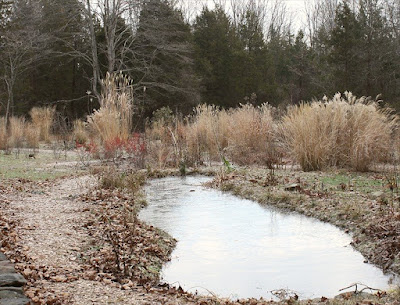
Much of the structure of my garden is native stone (argillite, known by old timers as "blue jingle" or "blue jingler") made into dry laid walls. So far we've built 300 to 400 feet of low wall at the base of the little manmade hill that raises the house above the wet landscape and along a curving path on the west side of the garden. Now I want to use the stone to build a raised linear planting area.
This will be at the far end of the little pond (shown above), which is about 40 feet long. Picture first a stone wall, 8 to 10 feet long, cutting diagonally across the end of the pond - a full visual stop, perhaps with a slanting top, rising from left to right (I haven't decided about that yet). On the other side of that transverse wall will be a raised planting area, trapezoidal in shape, at least 4 feet wide and probably 20 or 25 feet long. This stone planter will echo the shape of the pond, but will "bend" to the left. It will be about 18 inches high.
My garden is so wild I need to add more structured, formal elements for contrast. This new feature will make it possible to grow plants that can't survive in my wet clay soil. I'm thinking the new planting may be as simple as a row of boxwood balls - a formal, repetitive pattern as counterpoint to the naturalistic background planting. But that's still to be decided too.
The next photo shows the same area from another perspective. I have to move quite a few plants - winterberry hollies, a button bush, several aster tartaricus 'Jin Dai', assorted water irises... But that may be the easiest part.

The black and white photo highlights the roughly rectangular area in the center where the new stone planter will be. Here is the rough shape of the new stone feature, in plan view.

I found this really fascinating to see your thought processes.
ReplyDeleteI think it's essential to have some formals elements within a naturalistic garden, and it's exciting to me to work on such projects--as it obviously is for you, too. Though my garden is much smaller, I've got some symmetray going on SLIGHTLY in the stone paths, plants and same plant groupings, and a few cornerstone / anchor shrubs (arborvitae, buckthorn). Oh, and I have some black and white tulips jammed in between some miscanthus. I like that irony. Anyway, look forward to seeing your results.
ReplyDeleteBenjamin,
ReplyDeleteI like the black and white tulips with the miscanthus. I'd love to have some deciduous hedges of beech or something similar, but I don't have the courage to devote several years to a planting that might just drown in the wet. Evergreen hedges would be good, but what evergreen likes wet feet in the winter?
patientgardener,
ReplyDeleteMy "thought process" is an example of slow gardening. I'm already changing the shape of this new structural feature. One thing I do know; it needs to be a reflection of the pond and must be shaped and positioned to work aesthetically as a unit with the pond, and the rest of the garden.